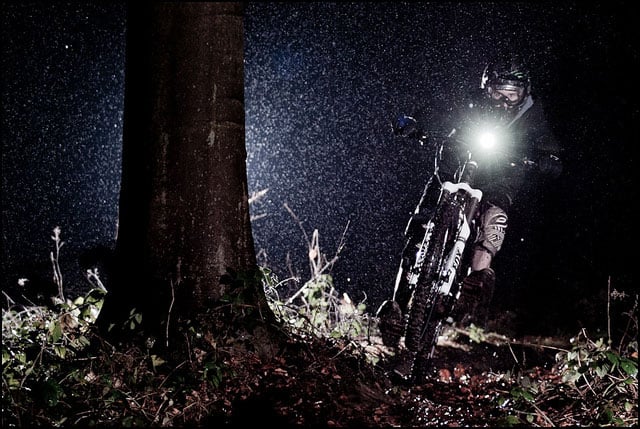
Luckily for most mountain bikers, the winter is not a time to get off the bike. Unless you have 8 feet of snow on the ground like much of the northeast does right now, mountain biking is typically thought of as a year around sport as long as you have the right gear to keep your body warm when the temps start to fall. Even in the southeast, we still have snow on the ground from Christmas, so to get in our much needed dirt time…we have to bundle up and hit the trail.
Layering Up For The Cold: What I Wear
I have gotten my best results on the bike in cold weather by wearing a set of layers that can be adjusted on the ride according to the varying temperatures on the trail and my changing body temperature. If I put on one jacket at the trail head that kept me warm while getting ready to ride and then tried to wear that same jacket on the trail…I would overheat within the hour. As our bodies get warmed up riding, our core body temperature rises at the same time. What felt nice and warm at the trail head can turn into an oven as you get through the first section of the long climb during the day.
As a rule of thumb, if I am a little bit cold at the start of the ride, that is a good thing.
After that…it is a balance of multiple layers that can be adjusted and stored easily during the ride. The following list is what I have on to get through the cold rides and still be able to rip on on the trail.
- Base Layer: I typically use a short sleeve jersey and SmartWool arm warmers as my base layer because that provides me even more versatility on the trail. You can also use a long sleeve, purpose built base layer for this option just make sure it is something that allows you to sweat and won’t completely absorb the salty water leaving your body.
- External/Internal Layer: For the layer that goes over my base layer, I use a thicker, long sleeve riding jersey. It is light, easy to pack if you need to take it off and it also allows for sweat to escape much like the base layer.
- External Layer: For the layer that sees the elements in the winter, I use a waterproof jacket (like the Showers Pass) or a light windbreaker depending on weather conditions. Ideally, the waterproof jacket also has zipper opens around the lower arms to let cool air into the hottest areas of your upper body (armpits). In the winter, the trails are typically wetter because water doesn’t evaporate as quickly, so the waterproof outer layer will keep you dry on the trail.
- Shorts/Pants: On the bottom, I wear thicker mountain biking shorts with a fleece lined, spandex shell underneath. Combined with SmartWool knee warmers and sometimes my 661 knee pads, that typically keeps my legs warm in conditions ranging down to the mid to low 20’s.
- Hands/Feet/Head: For my extremities, winter weather gloves, shoe covers and something that keeps your ears warm are a must.
Armed with my multiple layers of riding clothing, I hit the trail and adjust things as we hit different sections and time of day.
Why All Of The Layers?
Some of you might be wondering why I go through all of the trouble to wear multiple layers. Yes…you could find a one layer option that keeps you somewhere in the middle of cold and hot depending where you are on the trail, but there is one very important thing to remember.
Your Body Uses A Lot Of Energy In The Winter
Your body has to use a lot of energy to heat and cool your core. In warm weather riding, it usually has one task only…to cool everything down. In cold weather riding, your body could have to heat and cool your body multiple times throughout the ride expending a great deal of the energy you use to get the pedals to turn. The more you can do to relieve the stress from your body, the more you can turn that into energy that can be used on the trail.
You Are Still Going To Sweat In The Cold
Also, even though it is cold outside, you are still going to sweat. You can make sure that the sweat does not stay in your clothes (speeds up the getting cold process) by choosing layers that are designed to repel sweat instead of keep it in. If you wear one layer for all purposes, it can turn into what feels like an ice cube if you stop to rehydrate or eat on the trail.
The Temperature Will Change
And lastly, if you are anything like me…your body temperature can really rise while riding. The outside temperature might also be rising at the same time depending on what time of day you are on the trail, so being able to adjust for both of those variables on the trail can make the difference between a comfortable ride and feeling like you are in an oven. The higher number of lighter layers also means they are incredibly easy to pack should you want to take some of them off during the ride.
Watch For Trail Conditions
Another little thing to watch out for as you layer up and hit the trail are the trail conditions in your area. In the southeast, our main dirt source is red clay which is really prone to freeze thaw damage, so riding the trails in mud can really damage things in the long run. Check with your local mountain bike associations and make sure the trails are open to ride before you pack up all of your gear.
Image by willsimmons from the Bike198 Flickr Group

